This site is supported by our readers. We may earn a commission, at no cost to you, if you purchase through links.

Keep an eye out for the American Goldfinch, with its vibrant yellow feathers and black cap.
They stick around all year, though the color takes an olive turn in winter.
You’ll also see Yellow-rumped Warblers flaunting delightful yellow patches amid the gray during colder months.
In summer, the Baltimore Oriole’s warm yellow-orange glow enchants from tree crowns.
Don’t miss the cheerful Common Yellowthroat or the boldly patterned Magnolia Warbler during migration.
They are lively reminders of nature’s palette all year round.
Ready for a bird-watching adventure?
Table Of Contents
- Key Takeaways
- Year-Round Yellow Birds in Illinois
- Summer Resident Yellow Birds
- Winter Resident Yellow Birds
- Migratory Yellow Birds in Illinois
- Rare and Uncommon Yellow Birds
- Yellow Birds in Illinois by Season
- Identifying Yellow Birds in Illinois
- Attracting Yellow Birds to Your Yard
- Conservation Status of Yellow Birds in Illinois
- Tips for Birdwatching Yellow Birds in Illinois
- Frequently Asked Questions (FAQs)
- What kind of bird is bright yellow in Illinois?
- What is the most common yellow bird?
- What is the yellow bird that looks like a goldfinch?
- What sound does a yellow warbler make?
- What are the feeding habits of yellow birds?
- How do yellow birds communicate with each other?
- What predators threaten yellow birds in Illinois?
- How does weather affect yellow bird migration?
- What role do yellow birds play in ecosystems?
- Conclusion
Key Takeaways
- You’ll spot vibrant yellow birds like the American Goldfinch and Yellow-rumped Warbler year-round in Illinois, offering lively views and delightful songs.
- Attract these cheerful visitors by providing Nyjer and sunflower seeds, native plants, and a clean water source in your yard.
- Join a local birding club to enhance your birdwatching skills and connect with fellow enthusiasts, making outdoor adventures more rewarding.
- Bird migration and survival face challenges like habitat loss and predators, highlighting the importance of conservation efforts for these colorful species.
Year-Round Yellow Birds in Illinois
In Illinois, you’ll find the American Goldfinch and Cedar Waxwing brightening up neighborhoods all year long.
These cheery birds, with their distinctive colors and habits, are easy to spot even during the coldest months.
American Goldfinch Identification
Spot the American goldfinch with ease! Its brilliant yellow plumage and black cap make it memorable.
Want to impress your friends with birdwatching skills in Illinois? Here’s how:
- Color Change: Watch the goldfinch molt from bright yellow to olive in winter.
- Juveniles: Look for duller hues in young birds.
- Charming Tunes: Enjoy their sweet song variations.
Cedar Waxwing Characteristics
Elegance defines the cedar waxwing.
With its striking yellow belly and a mask reminiscent of a bandit, you’ll spot these stylish birds in Illinois year-round.
Known for their cedar waxwing diet of berries, they’re a spectacle in flight.
These gregarious birds charm with their unique cedar waxwing song and social behavior.
Enjoy their grace and mystery!
| Feature | Description | Note |
|---|---|---|
| Plumage | Yellow belly, gray wings | Distinctive mask |
| Diet | Berries, fruits | Cedar waxwing diet |
| Behavior | Social, flocking | Cedar waxwing nesting |
| Song | Soft, melodious | Cedar waxwing song |
American Goldfinch Habitat and Diet
So, you’ve learned about cedar waxwings.
Now, let’s talk about American Goldfinches!
These vibrant backyard birds thrive in various habitats.
Their diet mainly consists of:
- Seeds (especially sunflower and thistle)
- Insects (during breeding season)
- Weed seeds
Goldfinch Conservation efforts are important for their survival.
Their winter diet consists mostly of seeds.
Understanding their food sources helps you appreciate these lovely birds.
Attracting American Goldfinches to Your Yard
Why worry about attracting American Goldfinches? They’re delightful visitors!
Start with a goldfinch feeder filled with Nyjer seed types.
Add native plants to your garden; they love them.
For nesting, put up goldfinch nesting boxes.
Watching their cheerful behavior brightens any day.
Enjoy the vibrant sight of these birds playing freely in your yard.
It’s nature’s gift right at home!
Summer Resident Yellow Birds
In Illinois, summer brings a vibrant spectacle of yellow birds like the common yellowthroat, each adding a splash of sunshine to the landscape.
You might even mistake the female Baltimore oriole for a small piece of sunshine with wings, flitting among the trees.
Common Yellowthroat Breeding Season
The Common Yellowthroat’s breeding season is a fascinating time for bird watchers.
You’ll spot these migratory birds from mid-April to October in Illinois.
Here’s why they stand out:
- Nest Building: They weave hidden nests in dense shrubs.
- Breeding Behavior: Males flaunt black masks.
- Song Variation: Each male sings a unique tune.
- Habitat Preferences: Wetlands and brushy fields are favorites.
Baltimore Oriole Female Identification
After exploring the vibrant Common Yellowthroat, let’s uncover the Baltimore oriole females.
They sport a lovely yellow to yellow-orange hue with gray wings—perfect for blending into summer foliage.
Unlike their vibrant male counterparts, these ladies favor subtler tones.
Notably, Baltimore oriole females build nests in deciduous trees, often 20-30 feet above ground.
Watch them in treetops, creating intricate nests.
Their song adds charm, making them worthy of every birder’s attention.
Yellow Warbler Migration Patterns
Spotting that vibrant Baltimore oriole, you might wonder about another bright fellow—the yellow warbler.
This tiny traveler migrates from Central America to Illinois’ breeding grounds each summer.
Using well-established warbler migration routes, they time their journey perfectly.
Conservationists work hard to protect these routes, ensuring future generations will enjoy their cheerful presence.
Bird trivia fact: they love wet areas!
Eastern Meadowlark Habitat and Diet
While following yellow warbler trails, you might notice eastern meadowlarks within open fields, sharing habitats with yellow-headed blackbirds.
These birds enjoy grassland vibes, nesting close to the ground.
A laugh-worthy fact: they quite fancy insects, seeds, and grains, avoiding crowded feeders.
Their melodic songs with variations echo freedom.
Think of them as summer’s musicians orchestrating a delightful grassland concert.
Winter Resident Yellow Birds
While many yellow birds leave Illinois for the winter, you’ll still find some hardy species braving the cold.
Let’s explore the yellow-rumped warbler, a common winter resident that brightens up even the bleakest landscapes with its flashes of yellow.
Yellow-rumped Warbler Identification
Identifying a yellow-rumped warbler in winter is a treat, much like spotting its bright yellow cousin, the American Goldfinch, which feeds on nyjer and sunflower seeds.
Look for its gray body with vibrant yellow patches on the sides and rump.
These warblers often mingle with palm and magnolia warblers.
Their cheerful markings offer a splash of color during dreary months.
With field identification tips, recognize them amidst flocks, and enjoy the vibrant contrast they bring to the chilly season.
Yellow-rumped Warbler Habitat and Diet
You’re probably wondering what keeps a Yellow-rumped Warbler happy during winter in Illinois.
These birds love hanging out in open areas with plenty of fruiting shrubs and trees.
Their diet consists mostly of insects and leftover berries.
Think of them as nature’s cleanup crew.
They share their habitat with orange-crowned warbler and pine warbler, making wintering grounds bustling with activity.
If you’re interested in learning more about these birds, you can find Yellow bird ID guides and products online, such as those on Yellow bird gear.
Attracting Yellow-rumped Warblers to Your Yard
Drawing yellow-rumped warblers to your yard isn’t rocket science.
Start with a foolproof backyard setup that includes suet and raisins.
These treats cater to their diet.
Then, plant choices matter—think fruiting shrubs for winter feeding.
Toss in a simple suet recipe, and you’ll also tempt warbler cousins like the Cape May or Nashville warblers.
Your yard, their haven!
Migratory Yellow Birds in Illinois
Every spring and fall, Illinois becomes a hotspot for migratory yellow birds such as warblers and orioles.
You’ll find these feathered travelers flitting through treetops while enjoying a pit stop on their long journeys.
Palm Warbler Migration Patterns
Think of the Palm Warbler as a savvy traveler, journeying from wintering spots in the southeastern U.S. to breeding grounds in Canada.
They’ll pass through Illinois during their spring migration routes, often seen bobbing along the ground in open fields.
Conservation efforts help reduce threats during migration, ensuring these birds join fellow travelers like the summer tanager and orchard oriole without a hitch.
Magnolia Warbler Identification
Spotting the Magnolia Warbler in Illinois is like finding a splash of vibrant color amidst the leaves.
Its striking yellow plumage, accented with black streaks, sets this bird apart.
Listen for the Magnolia Warbler’s song, a sweet, melodic tune.
Often confused with the scarlet tanager, the key is in its contrasting wing pattern.
Indulge in nature’s treasure hunt for this beauty!
Nashville Warbler Habitat and Diet
During their spring migration, you’ll find Nashville Warblers flitting through Illinois’ forests.
These tiny birds prefer open woodlands and edges, nesting in low shrubs, often favoring habitats with young trees and saplings.
Their diet consists mainly of insect prey, like caterpillars and small beetles.
You might even catch a glimpse of their nesting behavior – a neat cup-shaped nest nestled amongst leaves.
Keep an eye out for these vibrant yellow birds!
Prothonotary Warbler Characteristics
Brighten your birdwatching with the striking Prothonotary Warbler!
They thrive in swampy habitats, singing cheerfully with a sweet, rolling song.
Their diet includes insects and snails, and they nest in cavities, adding charm to their vibrant lives.
Conservation efforts help safeguard these beauties.
With their lemon-yellow bodies, they’re like little sunbeams flitting through the trees.
- Prothonotary Warbler Song: Pleasant and rolling
- Prothonotary Warbler Nesting: Cavity dwellers
- Prothonotary Warbler Diet: Insects and snails
- Prothonotary Warbler Habitat: Swamps and wetlands
- Prothonotary Warbler Conservation: Increasing efforts
Rare and Uncommon Yellow Birds
You’ll need a keen eye to spot the rare and uncommon yellow birds in Illinois, as they aren’t regular visitors.
Species like the Evening Grosbeak and Yellow-Breasted Chat add a splash of unexpected color, making the search a rewarding challenge.
Evening Grosbeak Identification
When scanning for rare migratory wonders, the Evening Grosbeak stands out with its chunky build and thick beak.
Males flaunt striking yellow and black patterns, while females lean toward a softer gray.
Known for their strong voices and gregarious nature, listen for distinctive calls.
These birds enjoy coniferous forests, adding a burst of color and curiosity to your sightings.
Yellow-Breasted Chat Habitat and Diet
While identifying an Evening Grosbeak’s stark colors, you might wonder about the elusive Yellow-breasted Chat.
Found in dense shrubs and thickets, these chats flaunt vibrant yellow breasts.
Their diet is a mix of insects and berries, providing a balanced menu.
With distinctive chat calls, they’re noted for their chatty behavior.
Conservation efforts support their habitat, promoting healthy chat nesting and range.
Northern Parula Migration Patterns
Ever wondered how Northern Parulas manage their epic journeys?
Their migration kicks off with a melody, as these tiny warblers travel from breeding grounds in North America, where some species like the Western Meadowlark’s melodic song, to wintering spots in Central America.
But it’s not all sunshine and short flights—threats like habitat loss pose real challenges.
Conservation efforts aim to keep their epic migrations a success story.
Blue-Winged Warbler Characteristics
Picture the Blue-winged Warbler, a rare gem in Illinois’ avian world, with bright yellow feathers and striking gray-blue wings.
You’ll find them flitting about in shrubby fields, singing their buzzy song.
Their diet is mostly insects, making them excellent pest control.
They nest low in thickets, keeping a low profile.
This warbler’s range is delightfully limited, adding intrigue for birdwatchers.
Yellow Birds in Illinois by Season
Illinois’s yellow bird populations change dramatically throughout the year. You’ll find different species depending on the season, from spring migrants to winter residents, so let’s explore these seasonal shifts together!
Spring Migration Patterns
Spotting rare yellow birds can be thrilling, but have you ever pondered their spring migration patterns?
Birds often follow established flyways during spring migration, influenced by resource competition and food scarcity. Spring migration routes reveal delicate timing variations as these birds traverse new habitats.
They face threats during migration, but conservation efforts aim to ease their journey.
Look for:
- Warblers among budding trees
- Orioles in flowering gardens
- Vireos along sunny paths
Summer Breeding Season
As spring migration ends, birds find their summer breeding grounds in Illinois.
You’ll notice territorial behavior as males guard their breeding range fiercely.
Nesting habits vary, with some species selecting secluded spots.
Mate selection leads to intricate displays.
Observing nestling care is heartwarming—adults tirelessly feed their young.
Enjoy these glimpses into their summer rituals, nature’s ongoing drama.
Fall Migration Patterns
Falling leaves cue the swirling tapestry of yellow birds setting out on their fall migration through Illinois.
Watch as warblers, tanagers, and orioles navigate known migration routes.
Time your birdwatching to catch these vibrant travelers at hotspots like the Mississippi River flyway, but remember, threats abound.
Conservation efforts aim to protect these migrations, ensuring you can enjoy their colorful journeys for years.
Winter Resident Birds
After watching birds migrate, you’re not left in the cold.
Illinois hosts winter residents like the Yellow-rumped Warbler.
These warblers, sporting gray with yellow flashes, love winter bird feeders with sunflower seeds and peanut butter.
Their flocking behavior is a sight to behold.
Grab your binoculars for some Illinois birdwatching, where you can spot the charming American Goldfinches that thrive on seeds, especially sunflower and nyjer seeds from Illinois backyard birds, and identify these feathered friends during the chilly months!
Identifying Yellow Birds in Illinois
You can spot yellow birds in Illinois by examining their bright plumage and distinctive calls.
Pay attention to details like size and habitat.
Soon you’ll be the neighborhood’s unofficial bird expert.
Plumage and Coloration
Spotting yellow birds involves understanding their plumage and coloration, where nature shows off its artistic flair.
Warblers and orioles flaunt vibrant yellow hues, with seasonal changes adding complexity.
As bird enthusiasts learn to identify these species, they often explore online resources like birdwatching guides.
Through the molting process, they might swap brightness for subtle tans, a cunning mimicry tactic.
Whether rich golds or subtle tans, each bird wears its own unique color variation, a visual delight for birdwatchers!
Size and Shape
Knowing a bird’s color is helpful, but size and shape matter too! Think of it like this: you wouldn’t confuse a robin with a hummingbird, right? Here’s what to look for:
- Yellow bird size: Measure the bird against a known size (like your hand).
- Illinois bird guide resources can help with precise size measurements.
- Shape variations: Note the body’s overall shape – long and slender, or round and compact?
- Bird wingspan: A wider wingspan often indicates a larger bird.
- Body proportions: Compare the length of the head, body, and tail. Length comparison helps narrow things down.
Habitat and Behavior
You’ve noticed their size and shape; now, consider where yellow birds hang their hat.
From suburban backyards to open fields, these birds adapt across various habitats.
Their nesting habits are interesting, as they build intricate homes.
Social interactions range from harmonious feeding preferences to quirky territorial behavior.
Seasonal adaptations bring about fascinating changes in their daily routines.
| Habitat | Behavior | Seasonality |
|---|---|---|
| Suburbs | Nesting habits | Summer adaptations |
| Open fields | Territorial behavior | Year-round changes |
| Wetlands | Social interactions | Winter adjustments |
Song and Call Identification
Now that you’ve found their habitats, let’s focus on identifying these yellow birds by their songs.
Bird songs are like nature’s playlist, each note a clue.
Use field guides, sound recordings, and identification apps to recognize call variations.
Whether it’s a goldfinch’s sweet melody or a warbler’s quick trill, you’ll soon tune into their unique symphony.
Attracting Yellow Birds to Your Yard
You can transform your yard into a haven for yellow birds in Illinois by offering their favorite treats, like nyjer and sunflower seeds.
Add native plants and water sources, and you’ll soon enjoy a colorful chorus of these cheerful visitors.
Nyjer Seed and Sunflower Seeds
Attracting yellow birds like the American Goldfinch is a breeze with the right seeds.
Nyjer seed and sunflower seeds are top choices.
Imagine a feeder brimming with these goodies—it’s like an all-you-can-eat buffet for birds.
Also, they’re both readily available and affordable, so your yard can become a vibrant bird hotspot without breaking the bank.
Enjoy the show!
Native Plants and Vegetation
Through the lens of bird-friendly gardening, native plants are your best allies.
Choose Illinois wildflowers like coneflower and black-eyed Susan to bring yellow birds to your backyard.
They offer food and a wildlife habitat, making them perfect for backyard landscaping.
It’s a win-win; you enjoy the blooms, while the birds enjoy the feast.
Bird Feeders and Bird Baths
You’re inviting these yellow visitors to your garden party with feeders and baths.
To attract a variety of species, including the Northern Cardinal and Blue Jay, which are common in states like Mississippi Mississippi backyard birds. Opt for a variety of bird feeder types to attract different species.
A DIY bird bath provides a splash of fun and hydration.
Position feeders near cover for winter bird care, making your yard a hit spot for American goldfinches and their friends.
Creating a Yellow Bird-Friendly Environment
Want a yard buzzing with yellow birds? It’s easier than you think! Provide them with the essentials for a comfy home.
- Plant native flowers—they’re like a buffet for insects, which are bird food!
- Offer fresh water; a birdbath is a simple solution.
- Scatter sunflower seeds; they’re a favorite snack.
- Put up nesting boxes; they’re like bird condos.
- Protect their habitat; avoid using harmful pesticides.
Enjoy the show!
Conservation Status of Yellow Birds in Illinois
Exploring the conservation status of yellow birds in Illinois, you’ll find that these feathery gems face several challenges.
From habitat loss to climate change, understanding these threats helps you appreciate ongoing conservation efforts to guarantee their survival.
Threats to Yellow Bird Populations
Yellow bird populations in Illinois face serious threats from habitat loss and climate change.
Imagine their tiny bird committees discussing these issues over morning chirps!
Add in pesticide use and invasive species, and it’s a rough flight, much like the Northern Parula’s foraging challenges.
Disease spread is a sneaky thief, too.
These factors challenge their vibrant survival, reminding us how nature’s balance needs our careful attention.
Conservation Efforts and Initiatives
Amid threats like habitat loss and climate change, you might wonder how yellow birds in Illinois can thrive.
Efforts focus on bird banding and citizen science, empowering regular folks to contribute data.
Conservation groups collaborate tirelessly to protect these species.
By supporting these initiatives, you join a broader community dedicated to ensuring these vibrant birds continue to brighten our skies.
Protecting Habitat and Migration Patterns
Habitat loss, urban sprawl, and your backyard choices shape yellow birds’ lives in Illinois.
By planting native shrubs and setting up bird feeders, you create more welcoming spaces.
This ripple effect supports their migration patterns too.
Conservation efforts aren’t just for the experts; they start right at home.
So, why not team up and give these feathered friends a fighting chance?
Climate Change and Yellow Bird Populations
Climate shifts stress bird populations.
If you notice fewer yellow birds, it could mean they’re losing habitats or food sources.
Keep an eye on migration patterns; population trends might tell new stories.
- More heat equals less habitat.
- Food shortages hinder breeding success.
- Erratic weather alters migration.
- Public efforts can reverse trends.
Tips for Birdwatching Yellow Birds in Illinois
When you’re searching for yellow birds in Illinois, timing and location are key.
Equip yourself with a good pair of binoculars.
Consider joining a local birding club—it’s like Pokémon Go, but for real-life feathered friends!
Best Times and Locations for Birdwatching
Best birdwatching in Illinois hinges on timing and location.
Spring and fall migrations offer the greatest variety; consult a birding season calendar for peak times.
To attract yellow birds to your own yard, consider stocking up on Illinois bird seed.
Illinois birdwatching hotspots include the Shawnee National Forest and the Chicago area’s many parks.
Explore Illinois’ natural habitats, which have a diverse range of flora and fauna, including areas that attract common birds in local parks, focusing on areas with diverse vegetation.
Remember, patience is key! You’ll soon spot those vibrant yellow birds.
Birding Equipment and Accessories
Before you head out to spot those brilliant yellow birds, grab your binoculars for close-ups and a field guide for quick IDs.
A camera captures the moment, while weather-appropriate clothing keeps you comfy.
Birding apps? They’re like having a bird expert in your pocket.
These tools make your birdwatching adventure in Illinois both fun and fruitful.
Joining a Birding Community or Club
Once you’ve geared up, connecting with fellow birders can enrich your experience.
Joining a birding club offers camaraderie and learning opportunities through birdwatching events and field trips.
You’ll meet local experts and gain insights via online communities.
- Birdwatching events for new sightings
- Field trips to diverse habitats
- Local experts offering tips
- Online communities for ongoing support
Frequently Asked Questions (FAQs)
What kind of bird is bright yellow in Illinois?
Many Illinois birds boast bright yellow plumage. Similar to those found in neighboring states, like the Common Yellowthroat often seen in Minnesota’s marshy or wetland areas!
Depending on the season, you might spot an American Goldfinch, Baltimore Oriole, or even a Yellow Warbler.
Their vibrant colors are a treat for bird watchers!
What is the most common yellow bird?
Good things come in small packages, like the American Goldfinch.
It’s the most common yellow bird in Illinois, easily recognized by its vibrant yellow feathers and cheerful song.
Spot them in your backyard, enjoying sunflower seeds.
What is the yellow bird that looks like a goldfinch?
You might be looking at a female Baltimore oriole or a juvenile male, both of which resemble goldfinches with their bright yellow-orange plumage.
They’re frequent visitors in Illinois, especially during the warmer months.
What sound does a yellow warbler make?
What sound does a yellow warbler make?
With a flurry of notes, it sings a sweet, clear "sweet-sweet-sweet, I’m-so-sweet" tune that lights up spring mornings.
Their cheerful song is a hallmark of their territory.
What are the feeding habits of yellow birds?
Yellow birds in Illinois munch on seeds, insects, and fruit.
They feast on sunflower and nyjer seeds, enjoying a buffet of bugs and berries.
Some, like the American goldfinch, stick to a vegetarian diet.
How do yellow birds communicate with each other?
Birds communicate through songs and calls, using these sounds to attract mates, warn of danger, and establish territory.
Visual signals, like plumage displays and body movements, also play a role, creating a vibrant avian dialogue.
What predators threaten yellow birds in Illinois?
There are always hungry eyes out there in nature.
Yellow birds in Illinois face threats from predators like hawks, snakes, cats, and raccoons.
These crafty hunters exploit the environment, targeting nests and adult birds alike.
How does weather affect yellow bird migration?
Storms and strong winds can delay or disrupt their journeys.
Favorable weather, like tailwinds, helps them reach their destinations faster.
Temperature plays a role, influencing their energy levels and flight patterns.
What role do yellow birds play in ecosystems?
Yellow birds contribute to ecosystems by controlling insect populations, aiding pollination, and dispersing seeds.
Yellow birds also indicate healthy environments, like nature’s check-up.
Spotting them fuels curiosity and invites us into the wondrous world of nature.
Conclusion
Exploring nature’s gallery, these yellow birds in Illinois turn every outing into a vibrant experience.
From the cheerful American Goldfinch to the lively Magnolia Warbler, which can be spotted during their seasonal bird migrations, these winged wonders paint the skies across seasons.
You can invite them to your yard or stumble upon them in the wild.
Bring along your binoculars and join a local birding group for insights and camaraderie.
Each bird tells a story of survival, migration, and beauty in every fluttering moment.
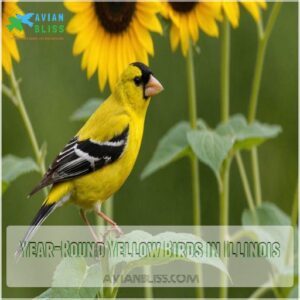
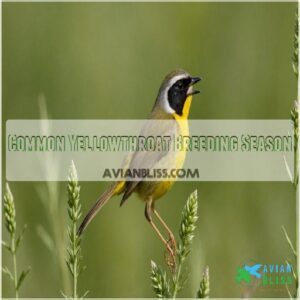
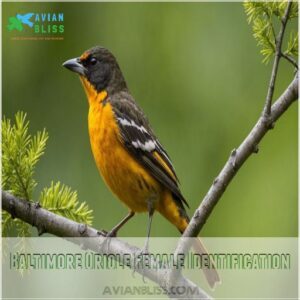

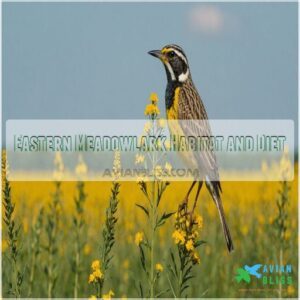
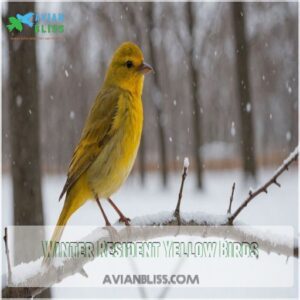





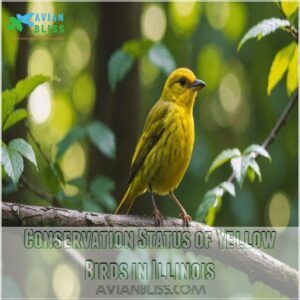
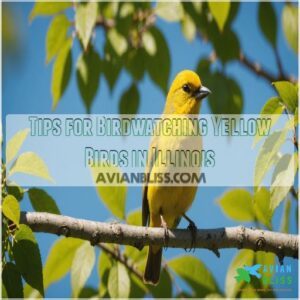
0 Comments